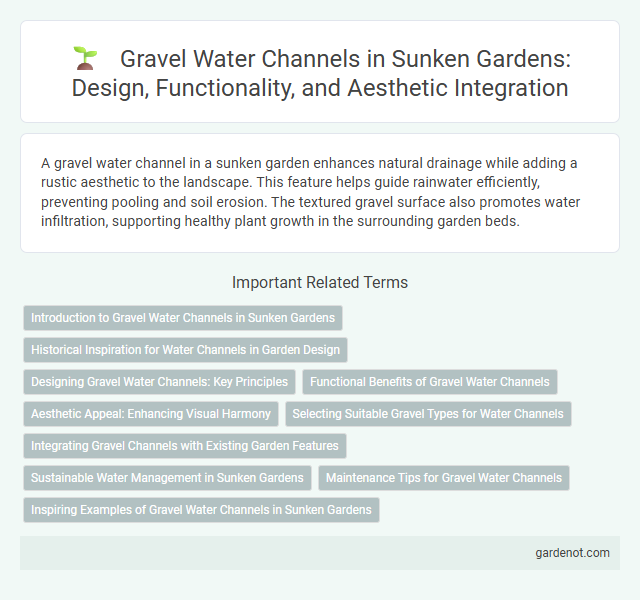A gravel water channel in a sunken garden enhances natural drainage while adding a rustic aesthetic to the landscape. This feature helps guide rainwater efficiently, preventing pooling and soil erosion. The textured gravel surface also promotes water infiltration, supporting healthy plant growth in the surrounding garden beds.
Introduction to Gravel Water Channels in Sunken Gardens
Gravel water channels in sunken gardens enhance natural drainage while providing aesthetic appeal through textured flow paths that blend seamlessly with surrounding vegetation. These channels utilize porous gravel beds to facilitate efficient water movement, reducing soil erosion and promoting plant health by maintaining optimal moisture levels. Designed to replicate natural watercourses, gravel water channels support biodiversity by creating microhabitats for aquatic and terrestrial species.
Historical Inspiration for Water Channels in Garden Design
Gravel water channels in garden design draw historical inspiration from ancient Persian and Islamic gardens, where intricate water channels symbolized life and purity. These channels facilitated natural irrigation while enhancing aesthetic appeal through rhythmic patterns and the soothing sound of flowing water. Modern sunken gardens incorporate gravel beds to replicate these traditional water channels, blending functional drainage with cultural heritage.
Designing Gravel Water Channels: Key Principles
Designing gravel water channels requires careful selection of gravel size and permeability to ensure efficient water flow and filtration. Proper channel slope and alignment minimize erosion and promote steady drainage, optimizing water management in sunken gardens. Integrating native vegetation along the channels further stabilizes the soil and enhances water retention capacity.
Functional Benefits of Gravel Water Channels
Gravel water channels in sunken gardens enhance efficient drainage by allowing water to quickly infiltrate and reduce surface runoff, preventing waterlogging and soil erosion. They also promote natural filtration, trapping debris and pollutants while maintaining optimal moisture levels for plant roots. These channels contribute to sustainable water management, supporting healthier plant growth and minimizing maintenance needs.
Aesthetic Appeal: Enhancing Visual Harmony
Gravel water channels in sunken gardens create a natural, textured pathway that complements the surrounding greenery and stone elements, enhancing overall visual harmony. The reflective surface of gently flowing water over smooth gravel adds dynamic light play, enriching the aesthetic appeal. These channels serve as seamless transitions between garden features, contributing to a balanced and tranquil landscape design.
Selecting Suitable Gravel Types for Water Channels
Selecting suitable gravel types for water channels in a sunken garden enhances drainage efficiency and prevents erosion. Opt for uniformly sized, angular gravel to facilitate optimal water flow and reduce clogging. Pea gravel or crushed stone with high permeability ensures durability while maintaining aesthetic appeal in the landscape design.
Integrating Gravel Channels with Existing Garden Features
Integrating gravel water channels with existing garden features enhances both aesthetics and drainage efficiency in sunken gardens. These channels facilitate natural water flow around key elements such as stone pathways, plant beds, and benches, promoting sustainable moisture management. Proper alignment and layering of gravel ensure seamless blending with the garden's topography while preserving structural integrity.
Sustainable Water Management in Sunken Gardens
Gravel water channels in sunken gardens serve as effective sustainable water management systems by facilitating natural filtration and promoting groundwater recharge. These channels reduce surface runoff, minimize soil erosion, and support water retention in urban green spaces. Incorporating permeable gravel materials enhances the ecological balance and ensures long-term water conservation.
Maintenance Tips for Gravel Water Channels
Regularly remove debris and sediment buildup from gravel water channels to maintain optimal water flow and prevent clogging. Inspect the channel edges for erosion or displacement, reinforcing with additional gravel or edging materials as needed. Ensure proper drainage by adjusting the gravel layer thickness and grading to avoid water pooling and promote efficient runoff.
Inspiring Examples of Gravel Water Channels in Sunken Gardens
Gravel water channels in sunken gardens enhance natural drainage while creating tranquil pathways that blend seamlessly with lush greenery. Notable examples like the Sunken Garden at UCLA and the Alhambra in Spain utilize finely crushed gravel channels to direct irrigation and rainwater efficiently, fostering plant health and aesthetic appeal. These channels optimize water flow, reduce soil erosion, and contribute to the serene ambiance characteristic of traditional sunken garden designs.
Gravel water channel Infographic

 gardenot.com
gardenot.com